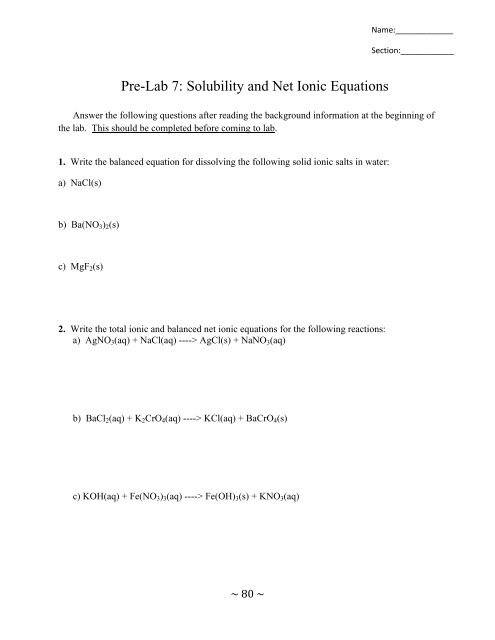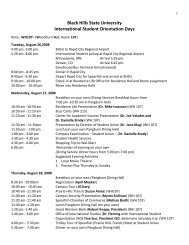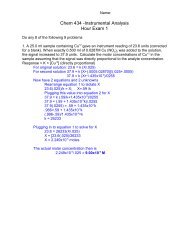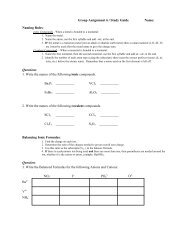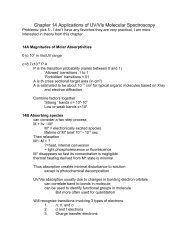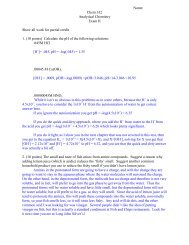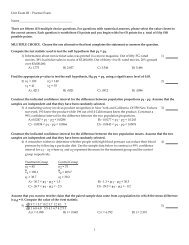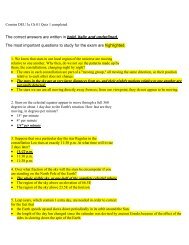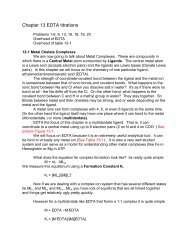Pre-Lab 7: Solubility and Net Ionic Equations
Pre-Lab 7: Solubility and Net Ionic Equations
Pre-Lab 7: Solubility and Net Ionic Equations
- No tags were found...
Create successful ePaper yourself
Turn your PDF publications into a flip-book with our unique Google optimized e-Paper software.
Name:_____________Section:____________<strong>Pre</strong>-<strong>Lab</strong> 7: <strong>Solubility</strong> <strong>and</strong> <strong>Net</strong> <strong>Ionic</strong> <strong>Equations</strong>Answer the following questions after reading the background information at the beginning ofthe lab. This should be completed before coming to lab.1. Write the balanced equation for dissolving the following solid ionic salts in water:a) NaCl(s)b) Ba(NO 3 ) 2 (s)c) MgF 2 (s)2. Write the total ionic <strong>and</strong> balanced net ionic equations for the following reactions:a) AgNO 3 (aq) + NaCl(aq) ----> AgCl(s) + NaNO 3 (aq)b) BaCl 2 (aq) + K 2 CrO 4 (aq) ----> KCl(aq) + BaCrO 4 (s)c) KOH(aq) + Fe(NO 3 ) 3 (aq) ----> Fe(OH) 3 (s) + KNO 3 (aq)~ 80 ~
This page was left blank intentionally!~ 81 ~
<strong>Lab</strong> 7: <strong>Solubility</strong> <strong>and</strong> <strong>Net</strong> <strong>Ionic</strong> <strong>Equations</strong>Objectives: In this experiment you will mix small quantities of aqueous ionic solutions together <strong>and</strong> insome cases, observe the formation of precipitates.General procedure:1. Mix small quantities of different ionic solutions together.2. Observe the absence or presence of a precipitate <strong>and</strong> its physical characteristics such ascolor, amount, etc.3. Formulate general solubility rules based on experimental observations.4. Write net ionic equations to describe the precipitation reactions.Safety• Wear safety goggles at all times.• Wear shoes that cover the entire foot.• Never touch, taste or smell chemicals.• Keep your h<strong>and</strong>s away from your face, eyes, nose <strong>and</strong> mouth.• Always wash your h<strong>and</strong>s before leaving the laboratory..Table of <strong>Ionic</strong> Salt SolutionsSolution#1Solution#2Solution#3Solution#4Solution#5Solution#6Set I Set IIBa(NO 3) 2Na 2SO 4BaCl 2Al 2(SO 4) 3NaI Sr(NO 3) 2AgNO 3CaCl 2NaNO 3AgNO 3KCl~ 82 ~
Part I. Writing Total <strong>Ionic</strong> <strong>and</strong> <strong>Net</strong> <strong>Ionic</strong> <strong>Equations</strong>Students will test ionic salt solutions for insoluble products. This is done be systemaicallycombining solutionsEquipment List:‣ Set 1 of the ionic salt solutions‣ 12 well spotting plateProcedure:1.Clean the Twelve well spotting plate.2.Spot a row of 5 spots on the spotting plate.3.Test this row against the other 5 solutionin the first set.4.Look for reactions <strong>and</strong> make observationsin the charts below.Results5.Choose another solution, <strong>and</strong> test againstthe remaining 4 solutions.6.Continue until all solutions have beentested against each other.Record observations in the chart below:-Look for precipitates, gas bubbles, etc.-Make notes on any colors seen in the precipitates/changes in solution color.Set # I~ 83 ~
DiscussionFor each of the solutions that showed a reaction, Record the solutions that were reacted <strong>and</strong>generate a total <strong>and</strong> net ionic equation for each reaction.SolutionsReactedDid AReactionOccur?Write out the Total <strong>Ionic</strong>Equation <strong>and</strong> <strong>Net</strong> <strong>Ionic</strong> Equation~ 84 ~
SolutionsReactedDid AReactionOccur?Write out the Total <strong>Ionic</strong>Equation <strong>and</strong> <strong>Net</strong> <strong>Ionic</strong> EquationAdditional Question #1. Which ion formed the most insoluble products?Additional Question #2. What is the chemical formula for the colored precipitates, <strong>and</strong> whatare their names?~ 85 ~
Part II. <strong>Pre</strong>dicting ReactionsStudents will test ionic salt solutions for insoluble products. This is done by systematicallycombining solutionsEquipment List:‣ Set 3 of the ionic salt solutions‣ 12 well spotting plateProcedure:1. Use the solubility laws to predict ifthe these reactions should occur.2. Record your predictions beforebeginning testing.3. Have the instructor initial the bottomof the page.4. Clean the Twelve well spotting plate.5. Spot a row of 5 spots on the spottingplate.6. Test this row against the other 5solution in the first set.7. Look for reactions <strong>and</strong> makeobservations in the charts below.8. Choose another solution, <strong>and</strong> testagainst the remaining 4 solutions.9. Continue until all solutions havebeen tested against each other.<strong>Pre</strong>dictionsFor each possible reaction indicate wither a reaction will occur or not, <strong>and</strong> what the reactionproduct is.Set #2SolutionsReacted1/2Will areactionOccur?Write the <strong>Net</strong> <strong>Ionic</strong> Equation for each.1/31/41/52/32/4~ 86 ~
2/53/43/54/5ResultsRecord observations in the chart below:-Look for precipitates, gas bubbles, etc.-Make notes on any colors seen in the precipitates/changes in solution color.Set #2SolutionsReactedDid aReactionOccur?Actual ResultsEvidence?Was thiscorrectlypredicted?1/21/31/41/5~ 87 ~
2/32/42/53/43/54/5~ 88 ~
<strong>Solubility</strong> <strong>and</strong> <strong>Net</strong> <strong>Ionic</strong> <strong>Equations</strong>Report SheetPart I. Writing Total <strong>Ionic</strong> <strong>and</strong> <strong>Net</strong> <strong>Ionic</strong> <strong>Equations</strong>Answer the following Questions1. Which solids formed non-whiteprecipitates?2. How many reactions had solid products?Name:_________________Partner:________________Section:________________3. Write the net ionic equations for the silvercontaining precipitatesPart II. <strong>Pre</strong>dicting ReactionsAnswer the following Questions1. # of incorrect predictions:2. What Ion formed the most solidprecipitates?3. What are the net ionic <strong>Equations</strong> of theproducts?Additional Questions:1. Which of the following salts are soluble in water <strong>and</strong> explain why:a) Na 3 PO 4 b) CaCO 32. Explain the following observations using solubility:a) A warm can of soda fizzes up when openedb) One pack of sugar will dissolve in 8 oz.of ice coffee at 35 ◦F , but 3 packets dissolve in ahot cup at 180 ◦F .~ 89 ~


